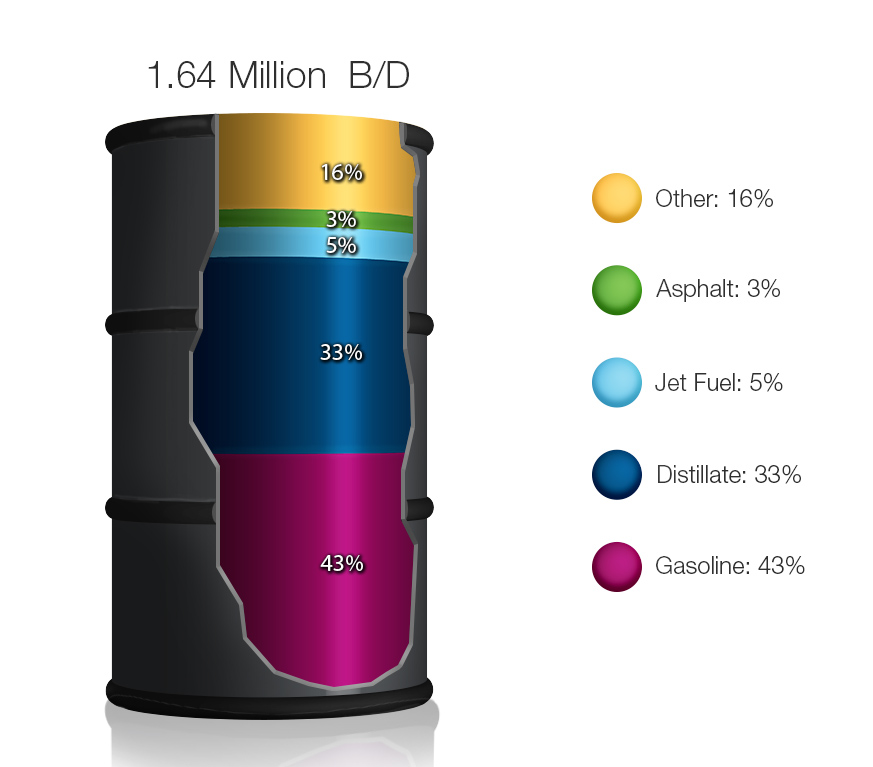Market Snapshot: How We Use Crude Oil Every Day
Connect/Contact Us
Please send comments, questions, or suggestions for Market Snapshot topics to snapshots@cer-rec.gc.ca
Release date: 2022-10-12
Oil has been used by people for thousands of years. The uses and applications of crude oilDefinition* have changed and evolved greatly with the onset of the modern oil industry in the late 1850s. Today, crude oil has over a thousand applications, such as powering cars, trucks, locomotives, power plants, factories, and ships; providing lubricants, greases, waxes, and asphalt; and as the source for petrochemical products like pharmaceuticals and plastics present in our daily lives.
Crude oil is not used in its raw form and must be refined into useable petroleum products.Definition* Footnote 1 Generally, these oil products can be grouped by fuels (gasoline, diesel, jet fuel, heavy fuel oil, still gas), industrial products (asphalt, lubricants, waxes, paraffins, coke), and petrochemical feedstocksDefinition* (naphtha, gasoil, propane, butane, ethane). Although petrochemicals account for less than 5 to 6% of all oil demand, they have by far the largest number of applications. Resins, coatings, pharmaceuticals,Footnote 2 fibers, solvents, plastics, and othersFootnote 3 are used to manufacture many other productsFootnote 4 like running shoes, clothing, and electronic equipment.
In 2021, Canadian demand for petroleum products was 1.64 million barrels per day.Footnote 5 Canadian demand of oil as fuel accounts for 81% (with gasoline accounting for 43%, followed by distillatesFootnote 6 with 33%, and jet fuel with 5%). Industrial and petrochemicals applications account for the remaining 19% (asphalt with 3% and other products and petrochemicals with the remaining 16%) (Figure 1).
Figure 1: Canadian oil product demand in 2021

Source and Description
Source: Statistics Canada Table 25-10-0081-01
Description: This chart shows the share of the different oil products consumed in Canada in 2021. “Distillate” includes diesel fuel, heating oil (mazut) and gas oil. “Other” includes petrochemical feedstocks, lubricants, waxes, and miscellaneous products.
Most oil products have seasonal demand. For example, gasoline demand is highest during the summer months, as people drive more. The same is true for asphalt, with the bulk of road surfacing and house roofing maintenance occurring in summer. Diesel demand is also seasonal, as crop harvesting happens in the fall and early winter and heating oilFootnote 7 demand peaks during winter.Footnote 8
While oil is used in many parts of our daily lives, there are increasing efforts to transition away from oil and other fossil fuels. According to the International Energy Agency, the energy sector is the source of about three-quarters of global greenhouse gas (GHG) emissions. Canada’s emissions from the energy sectorFootnote 9 accounted for 80% of the country’s total GHG emissions in 2020.Footnote 10 Canada has committed to reducing its GHG emissions by 40 to 45% below 2005 levels by 2030 and achieving net zero GHG emissions by 2050. If Canada maintains its current pace of action to reduce emissions from the country’s energy system,Footnote 11 total Canadian energy demand is expected to fall, driven by declining crude oil and other fossil fuels’ demand, increasing energy efficiency and growing use of renewables.Footnote 12
- Date modified:
